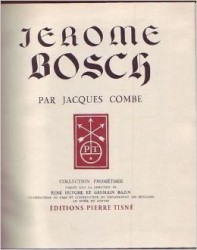
Combe 1946
Jérôme Bosch (Jacques Combe) 1946
[Éditions Pierre Tisné, Paris, 1946, 107 pages + 142 illustrated pages]
[Also mentioned in Gibson 1983: 3 (A14)]
Combe doesn’t doubt that for Bosch’s contemporaries his art already had the esoteric character that seems so enigmatic to us today. According to Combe Bosch’s paintings could only be fully understood by a small number of congenial insiders who felt at ease in the same cultural world that inspired Bosch. As far as the content of Bosch’s art is concerned, this world is the world of mysticism, of Ruusbroec in particular and of his followers, the adepts of the Modern Devotion. Under their influence Bosch’s large triptychs represent spiritual life and depict the disquiet of human conscience when it has to choose the correct way of life. Bosch’s hermit panels represent some moments of spiritual triumph over this mental disturbance.
According to Combe the correctness of this vision (the influence of mysticism on Bosch) is confirmed by the success Bosch’s paintings enjoyed in sixteenth-century Spain. Is it sheer coincidence that this country was attracted by paintings representing the ideas of Flemish mysticism in a period when Spanish mysticism was flourishing? In sixteenth-century Spain Bosch is admired, studied and interpreted in a proper way.
Bosch found the expressive forms for his ideas in the world of mystical symbolism, but also in the field of esoteric sciences: magic, Tarot and in particular – from the Lisbon St Anthony triptych on – alchemy. In the fifteenth century the alchemists were very active and, being connected with different kinds of hereticism, they were continuously associated with witchcraft and black magic. In the Lisbon St Anthony and in The Garden of Earthly Delights (Madrid) Bosch uses a lot of alchemical symbols, but always in a context of evil, deceit and viciousness, which agrees with the attitude of such humanists as Sebastian Brant towards alchemy.
Combe also spends some pages on the aftereffect of Bosch. His imitators have sometimes produced nice paintings but they lacked the authenticity and genial spirit of their big example. Only Peter Bruegel the Elder succeeded in creating an original and important oeuvre by adding his own genius to Bosch’s lessons. Bosch’s landscapes have been most influential on later generations of painters.
In the twentieth century the art of Bosch is closely related to the work of the Surrealists. Their symbolism also has a permanent erotic touch and just like Bosch they tried to paint man, not in the way he pretends to be, but in the way he really is in his most hidden and intimate nature. This explains the modern character of the art of Bosch and is the reason why it still appeals to us.
[explicit]